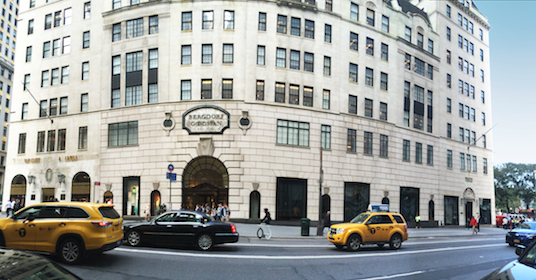
BY JACKSON CHEN | On a busy Fifth Avenue, passing tourists disrupt the flood of pedestrian traffic to snap photos of a long famous luxury department store. For some, the Bergdorf-Goodman building, between 57th and 58th Streets, is a go-to shopping destination, while others treat it more as an extravagant backdrop as they pose underneath the tall arches of the store’s entrance.
However, the Bergdorf-Goodman building may achieve more than digital permanence in the picture collections of untold numbers of tourists as the city’s Landmarks Preservation Commission (LPC) pushes along a possible landmark designation for the building housing the famed department store.
In an effort to address the dozens of historic properties that have fallen into landmark designation limbo, the Commission recently announced a Backlog Initiative that would address 95 properties considered for designation dating all the way back to the 1960s, but which have yielded no final action.
Of the 32 Manhattan properties among the backlogs, one of them is home to the legendary Bergdorf-Goodman, at 754 Fifth Avenue. Scheduled as an agenda item along with 11 other properties for a November 5 special hearing, the Bergdorf building, regardless of whether the LPC comes down for or against a designation, would then proceed to its own public hearing allowing both stakeholders and the public to offer verbal or written testimony. The deadline for a decision is December 2016, by which time the LPC will approve a landmark designation, reject a designation, or issue a no action letter, which removes the item from the calendar with no judgment on its merits for designation. A de-calendared property can be considered again for designation at a later time, whereas a vote against designation is final.
The New York Landmarks Conservancy, a non-profit group dedicated to “preserving, revitalizing, and reusing New York’s architecturally significant buildings,” has submitted a request for designation for the Bergdorf-Goodman building. “It’s one of the premiere stores and it’s certainly iconic for the city,” Peg Breen, president of the Conservancy said of the building. “A lot of people, whether they’re residents or tourists, know about the Bergdorf and they want to see it.”
The luxury goods department store was founded in 1899 by the eponymous French immigrant tailor Herman Bergdorf, who was later joined in the business by his apprentice Edwin Goodman. The store moved to its current location in 1928, after purchasing the land from Alice G. Vanderbilt, the widow of Cornelius Vanderbilt II, who could no longer pay her taxes on a 45-year-old mansion, the largest ever built in the US, on the site. After Bergdorf was bought out and Goodman passed away, Edwin’s son, Andrew Goodman, oversaw the store and positioned Bergdorf-Goodman as a more exclusive alternative to competition like Saks, Barneys, and Bloomingdale’s.
For preservationists like the Historic Districts Council’s executive director Simeon Bankoff, the Bergdorf-Goodman building has served as a gateway into the Fifth Avenue high-end retail district that has stood the test of time. “There’s a whole history of the evolution of department stores and luxury buildings on Fifth Avenue,” Bankoff said, “of which Bergdorf is the best remaining intact example.”
On top of its history of luxury commerce in Manhattan’s prime retail corridor, many New Yorkers also see architectural merit in designating the Bergdorf-Goodman building as a landmark. Known for an early 20th century modern architectural style with distinctive tall, intricate arches above the doorways, the building has changed very little since its construction in the ‘20s, according to Andrea Goldwyn, the Conservancy’s director of public policy. She said the only alterations made were a new doorway in the ‘80s. Most of the sand-colored building remains pristine, though signs of age are apparent with the black stone stains near the Bergdorf-Goodman logo above the store’s refurbished main entrance.
Discussion of landmark designation for the Bergdorf-Goodman building began in 1970, but the LPC decided against taking any action based on overwhelming resistance from the owner at the time, the junior Goodman, according to city records. The matter was deferred to a later time. In 1980, the Commission again decided to table the issue until another time.
Forty-five years after Bergdorf’s original landmark discussion, preservationists are pleased the LPC is working to tackle the numerous possible designations throughout the city. “Buildings should not linger for years or decades,” the Conservancy’s Breen said. Commending the Commission for its planned hearings, she said each of the 95 properties deserved their “day in court.”
In terms of landmark merit, the Historic Districts Council’s Bankoff said that the Bergdorf-Goodman building is a no-brainer. He voiced concern, however, that the property’s current owner would join the discussion closer to the designation decision and call for very loose regulation, and he predicted its architectural significance would be called into question.
“As the November 5 hearing draws closer, I would not be surprised if it starts getting circulated that the building is not meritorious,” Bankoff said.
He noted that the Crown Building across the street from Bergdorf, which sold for roughly $1.75 billion in December 2014, serves as a good reference point in assessing the property value the owner of the Bergdorf property would be looking to maintain by keeping its development options open.
Sharing Bankoff’s sentiments, Breen worries about the economic incentives in a neighborhood that is home to skyscrapers like the nearby Trump Tower and the Solow Building. “57th Street is the home of the supertowers, so there’s a lot of development pressure,” said Breen, who argued that the merits of landmarking should outweigh the economic pressures.
Representatives of Madison Capital, the real estate investment company that is the asset manager for 754 Fifth Avenue, declined comment on the merits of the landmarking issue. The owner, 754 Fifth Avenue Associates, L.P., identified in New York State records as a foreign limited partnership, could not be reached for comment.





































